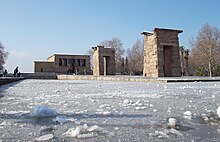Temple of Debod
| Debod in hieroglyphics | |||||
|---|---|---|---|---|---|
Ta-hut T3-hwt Debod |
|||||
| Temple of Debod. | |||||
The Temple of Debod is an ancient Egyptian - Sub-Nubian temple that was rebuilt in Madrid . It originally stood 15 km south of Philae on the banks of the Nile near the first Nile cataract in the immediate vicinity of Debod .
The goddess Isis of Philae was worshiped together with Hor-pa-chered by Philae in a sanctuary near Debod . The southern temple complex of Debod formed part of this sanctuary; the northern half was dedicated to " Amun of Debod". The old temple complex of Debod is already occupied in the 8th dynasty ( first interim period ).
history
The new temple was built by Ptolemy IV . In the early second century BC The Nubian king Adikhalamani of Meroe had a small chapel built in honor of the god "Amun of Ta-hut" near the village of Debod. The chapel was known as the "Chapel of Reliefs". There were numerous inscriptions and reliefs in it, including two sacrificial scenes where the god Hor-pa-chered is given food.
Later on, various Ptolemaic kings added new chambers around the original core of the complex. Augustus later had the forecourt built. Descriptions of the decorations and inscriptions in the forecourt have only survived from reports by travelers to Egypt, for example from another scene of sacrifices in honor of Hor-pa-chered. Further enlargement and beautification work took place under Tiberius and probably Hadrian .
Representations
chapel
Hor-pa-chered, to whom a food offering is made with Uto , can be seen as a standing naked deity with a double crown , youth lock , pectoral , ankh sign and with the left hand on the mouth; in another victim scene together with Nechbet with similar iconography .
Forecourt
In a ritual scene the king stands in front of Isis, Osiris , Schepesetneferet , Imhotep and Hor-pa-chered. The wall on which the reliefs were attached has meanwhile been destroyed. There Hor-pa-chered appeared as a standing god with a cloak , double crown, youth lock and heart amulet; holding the right hand to the mouth and a Rechit in the left hand .
Rescue from flooding
The construction of the Aswan High Dam in 1960 put a number of archaeological monuments in the Nile region at risk of being flooded. Therefore, UNESCO issued an international appeal to save the unique cultural heritage in southern Egypt. In recognition of Spain's help in saving the Abu Simbel temple , the Egyptian government donated the Debod temple to Spain in 1968.
However, the temple was dismantled as early as 1961 and temporarily stored on the so-called elephant island near the dam. The large individual blocks remained there until April 1970 when they were moved downstream to Alexandria . In June 1970 the blocks were put on a ship and transported via the port of Valencia to Madrid.
New home
The temple was then rebuilt in one of the most beautiful parks in Madrid , near the Madrid Campo del Moro and the Parque del Oeste (German: West Park ) on the site of a former military barracks (Cuartel de la Montaña). Open to the public since 1972, the temple is one of the few examples of ancient Egyptian architecture that can be viewed outside of Egypt, as well as the only exhibition of its kind in Spain.
literature
- Dieter Arnold : The temples of Egypt. Bechtermünz, Augsburg 1996, ISBN 3-86047-215-1 , pp. 90-91.
- Hans Bonnet : Debod. In: Lexicon of Egyptian Religious History. Volume 3rd unchanged edition. Nikol, Hamburg 2000, ISBN 3-937872-08-6 , p. 149.
- Günther Roeder : Debod to Bab Kalabsche. Volume 1. Imprimerie de l'Institut français d'archéologie orientale, Cairo 1911, pp. 1–100 ( PDF; 17 MB ).
- Sandra Sandri: Har-Pa-Chered (Harpokrates). The genesis of an Egyptian child of gods (= Orientalia Lovaniensia analecta. Vol. 151). Peeters, Leuven et al. 2006, ISBN 90-429-1761-X , (also: Mainz, Univ., Diss., 2004).
Web links
- Ayuntamiento de Madrid | Templo de Debod (in Spanish)
Individual evidence
- ↑ László Török, in: Fontes Historiae Nubiorum, Vol. II , Bergen 1996, p. 591.
Coordinates: 40 ° 25 '26.6 " N , 3 ° 43' 3.8" W.



